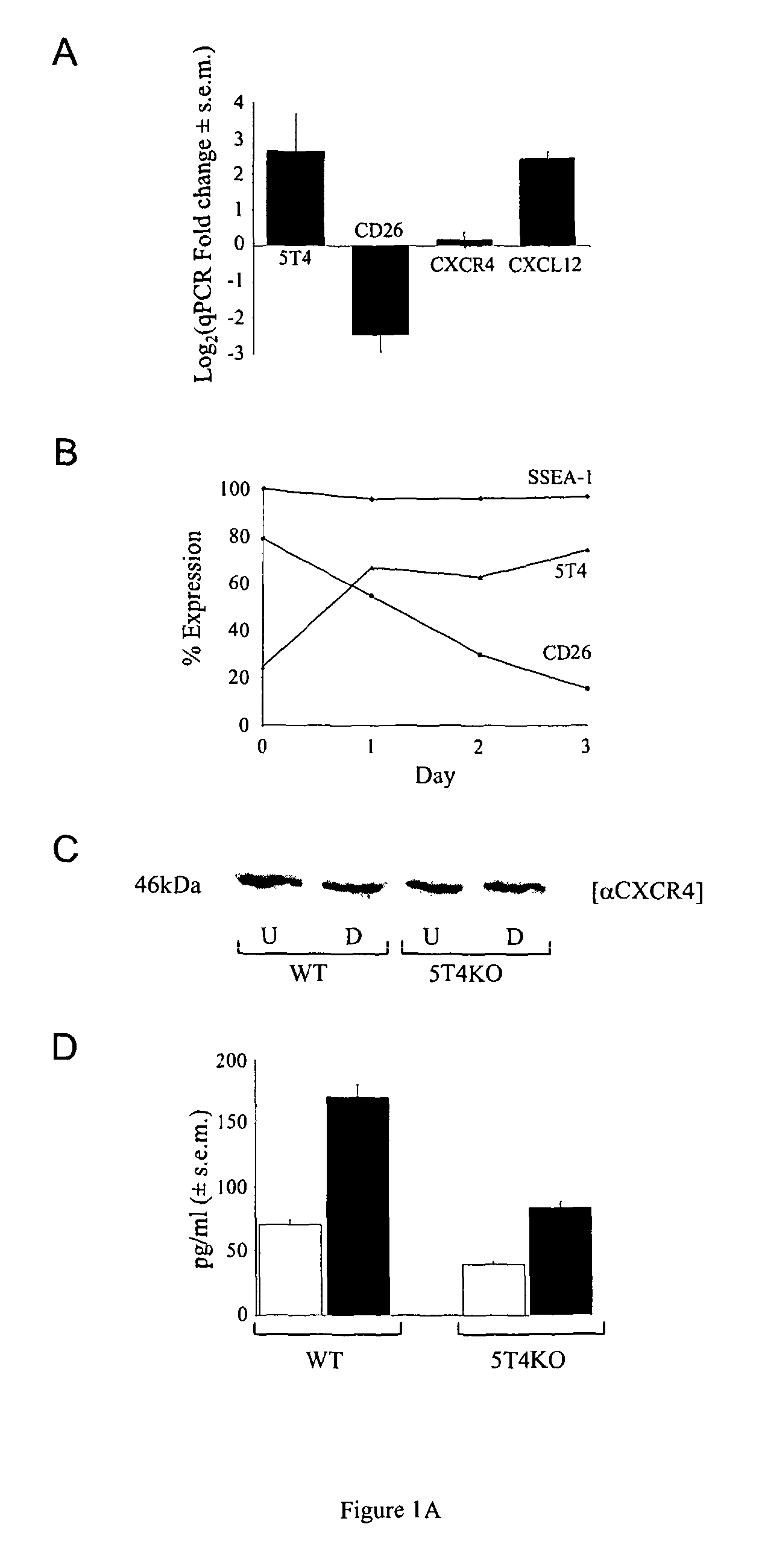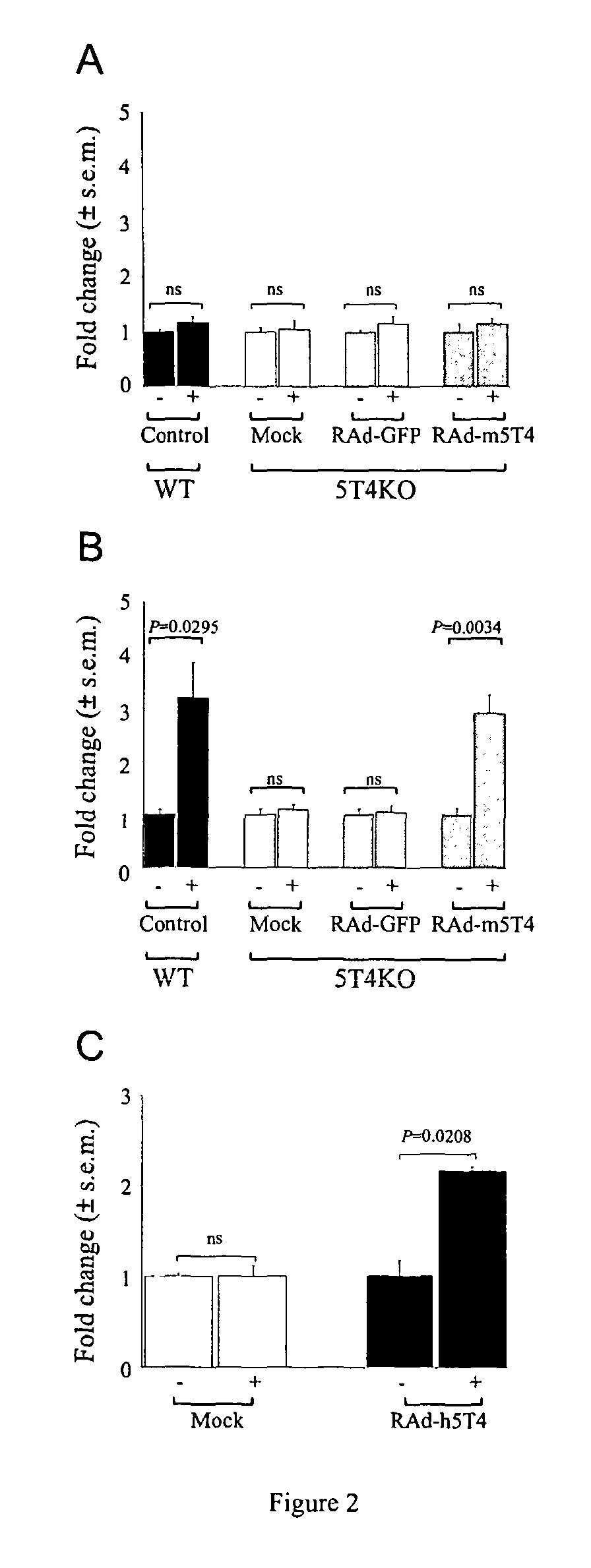Inhibition of the interaction between 5T4 oncofoetal glycoproteins and CXC chemokine receptors as a method of identifying chemotaxis inhibitors
a technology of cxc chemokine receptor and oncofoetal glycoprotein, which is applied in the field of methods, can solve the problems of poor prognosis, significant challenge, and cancer metastasis treatment, and achieve the effect of being a useful target for treating pathological inflammation
- Summary
- Abstract
- Description
- Claims
- Application Information
AI Technical Summary
Benefits of technology
Problems solved by technology
Method used
Image
Examples
example 1
Differentiating mES Cells Show 5T4-Dependent CXCL12 Chemotaxis
[0208]A comparative microarray of undifferentiated (5T4 −ve) and early differentiating (5T4 +ve) mES cells identified a significant downregulation of CD26, upregulation of CXCL12 but no change in the CXCR4 transcripts [30]. These data were confirmed by qPCR (FIG. 1A) and FACS analysis showed that as the ES cells differentiate cell surface expression of CD26 decreases while 5T4 increases; by contrast the pluripotent ES marker SSEA-1 did not significantly change over this time (FIG. 1B). The adherent cells were harvested for FACS analysis using trypsin-EDTA and CXCR4 is trypsin sensitive so its cell surface expression could not be accessed by this method. Western blot analysis shows there is no change in the total CXCR4 expression upon differentiation of either WT or 5T4KO ES cells (FIG. 1C). Increased CXCL12 was detected in the culture medium by ELISA after 3 days of differentiation (74±4 vs 180±9 pg / ml) (FIG. 1D). To exam...
example 2
Cellular Location of CXCR4 in Differentiating ES Cells
[0209]Following LIF withdrawal, both WT and 5T4KO ES cells undergo an EMT with cells eventually becoming dispersed with an arborized morphology. The expression and cellular localization of 5T4 and CXCR4 molecules before and after differentiation was determined by immunofluorescence of fixed cells grown on glass plates (FIG. 3A). Undifferentiated WT-ES cells are 5T4-negative with CXCR4 expression low and intracellular; following differentiation both molecules can be detected at the cell surface with some areas of co-localization. By contrast, differentiated 5T4KO ES cells show only intracellular CXCR4 expression. It is apparent that at least some 5T4 and CXCR4 molecules co-localize to lipid rafts in differentiating WT but not 5T4KO differentiating ES cells where CXCR4 remains intracellular. However, when differentiating 5T4KO ES cells are infected with RAd-m5T4, CXCR4 can be detected at the cell surface co-localized with 5T4 molec...
example 3
Role of 5T4 Expression in the CXCL12 / CXCR4 Axis in Mouse Embryo Fibroblasts
[0210]A 5T4 dependency for CXCR4-mediated chemotaxis is also apparent in MEFs as shown by: (1) a 5T4 gene dose influence on CXCL12 chemotaxis in WT, heterozygote and KO MEFS (FIG. 3a); (2) the restoration of the chemotactic response of 5T4 null MEF by RAd-m5T4 (FIG. 3b); and (3) the co-localization of some CXCR4 molecules with typical punctuate 5T4 cell surface expression in WT MEFs while 5T4 null MEFs show only intracellular CXCR4 (FIG. 3c) that can be rescued at the cell surface by RAd-m5T4 (FIG. 3d).
[0211]We next examined the role of 5T4 in the CXCL12 / CXCR4 axis by analyzing CXCL12-induced activation of key intracellular signalling effectors ERK and AKT in both WT and 5T4 null MEFs (FIG. 3e). These data demonstrate that in WT MEFs classical signal transduction pathways for the CXCL12 / CXCR4 axis are active but in the absence of 5T4 both ERK and AKT pathways are disrupted and the phosphorylation status of th...
PUM
| Property | Measurement | Unit |
|---|---|---|
| molecular weights | aaaaa | aaaaa |
| molecular weights | aaaaa | aaaaa |
| molecular weight | aaaaa | aaaaa |
Abstract
Description
Claims
Application Information
 Login to View More
Login to View More - R&D
- Intellectual Property
- Life Sciences
- Materials
- Tech Scout
- Unparalleled Data Quality
- Higher Quality Content
- 60% Fewer Hallucinations
Browse by: Latest US Patents, China's latest patents, Technical Efficacy Thesaurus, Application Domain, Technology Topic, Popular Technical Reports.
© 2025 PatSnap. All rights reserved.Legal|Privacy policy|Modern Slavery Act Transparency Statement|Sitemap|About US| Contact US: help@patsnap.com



